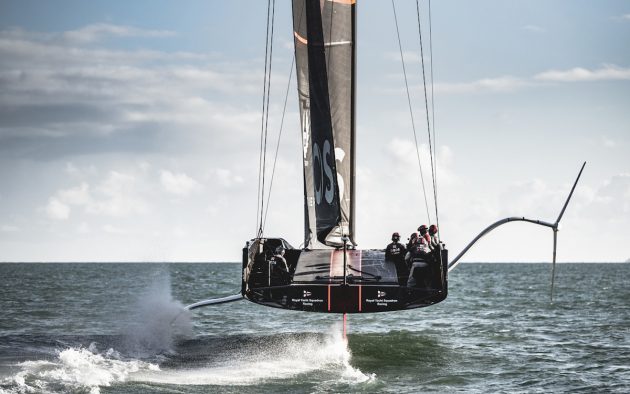INEOS Team UK skipper Ben Ainslie tells Mark Chisnell why analytics really count in the America’s Cup AC75 one-boat development phase
Ten years ago Brad Pitt’s movie Moneyball sparked an explosion of interest in sporting statistics, an interest that is now reflected everywhere from fantasy football leagues to the NFL. The concept was simple; data analytics can make a huge difference to outcomes on the field of play.
This was old news to America’s Cup teams, where data analysis has been part of the game since the early 1980s. In those days electronic sensors and computers had their limitations and the technology to measure performance to the required accuracy just didn’t exist.
The solution was to sail two boats close together, making it much easier to see even very small speed advantages. There were still problems: the boats were often in different winds, there were variations in wind shear and wind gradient that couldn’t be measured, and generally there was a lot of noise in the data.
But it was still the best process available, and for three decades it defined the MO of serious Cup teams, all running two boat programmes. The protocol for the 36th America’s Cup has banned it though, leaving teams to find other ways to improve performance with just a single boat out on the water.
Fortunately, data analysis now has advanced to the point that a single AC75 boat is all you need for a lot of the testing and experimentation.
“The job used to be about running straight line tests and getting good data results from that,” explained Ainslie. “Making sure the boat or the sails or the crew were changed at the right time, that we did enough tests on both tacks, that boats swapped sides to make sure the differences in the wind were ironed out – all so the tests were as accurate as possible.
“Now it’s much more about [running tests to] validate the VPP [Velocity Prediction Program] and simulation results out on the water. So for example, if the VPP says the boat will do 36 knots at a particular wind speed and wind angle, then we’re trying to confirm that as close as we possibly can.
“But it’s also about establishing things like the take-off speed of the boat – what our tools are predicting we should be able to do and what we can actually do in practice. And the more that we can confirm those predictions, then the more that we can feed that back into the models and the simulation, and the whole thing becomes more and more accurate.
“The speed of the development is astonishing. The designers and the engineers do an amazing job to be able to keep pace with those developments, and it’s very exciting to be a part of it,” said Ainslie.
Article continues below…
Road to the America’s Cup podcast: What can sailing simulators teach us?
The reason is simple: every other means of performance evaluation has been neutered – or, at the very least, significantly…
Road to the America’s Cup podcast episode 1: Imagining the AC75
There is no doubt that the AC75 is a remarkable boat; a monohull designed to fly, engineered to reach speeds…
The other big change in the last decade is that access to the data has been broadened and deepened within the team; it’s been taken out of the silo and democratised. “We’ve built a tool we call ‘Replay’, and that effectively brings all of the data into one place, not just the numbers but also the video from the cameras on board the boat and off the boat, the drones and everything else.
And that’s really useful in the debrief scenario, but it also allows anyone that’s interested to go back and check things for themselves. “I think that’s the biggest difference to the days when we were two-boat testing, when it was mostly just about which boat or keel or sail won the tests and by how much.
“Now we have so much more information from the boat. With all the different sensors it’s given us access to so much more data – and for our engineers that’s absolutely critical in learning and understanding this new concept of boat and then designing a faster overall product,” concluded Ainslie.






